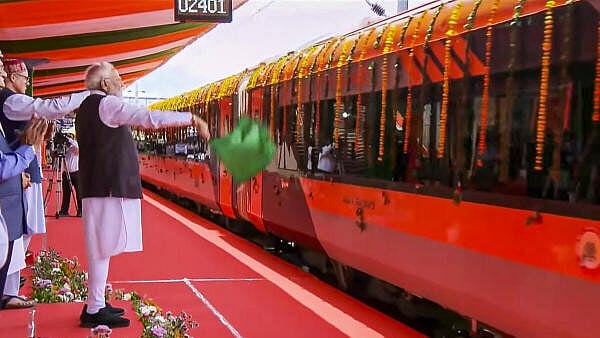
Prime Minister Narendra Modi flags off the Vande Bharat Express to inaugurate the Katra-Srinagar Vande Bharat service
Credit: YT/@narendramodi
Srinagar: Calling India’s precision airstrikes on May 6 a “nightmare for Pakistani terrorists,” Prime Minister Narendra Modi on Friday said that Jammu and Kashmir had finally been freed from the grip of terrorism.
He was addressing a public rally in Katra during his first visit to the Union Territory since the April 22 terror attack in Pahalgam, which claimed 26 lives.
During the visit, Modi inaugurated the long-awaited 272-kilometre Udhampur-Srinagar-Baramulla Railway Link (USBRL)—a transformative infrastructure project over three decades in the making. The Prime Minister flagged off the Vande Bharat Express connecting Baramulla and Katra, marking a significant milestone in regional mobility and economic integration.
Recalling the Pahalgam terror attack, Modi hailed India’s military retaliation—Operation Sindoor—as a powerful response. “Just a month ago, terrorists in Pakistan saw their doomsday. Pakistan never imagined India would penetrate deep into their territory and destroy terror infrastructure,” he said, adding that the strike served as a message of humiliation and defeat for those behind the attack.
Modi accused Pakistan of attempting to destabilize the region by targeting civilians and places of worship in border areas like Poonch. “They tried to divide us by attacking temples, mosques, gurdwaras, and churches. They tried to cripple Kashmir’s economy and incite communal violence by killing innocents in Pahalgam—but they failed. The people’s unity defeated their designs.”
He made special mention of a poor worker, Adil, who was shot dead by terrorists while trying to resist the attack in Pahalgam. “Tourism connects people, but our neighbouring country has always tried to disconnect humanity. Adil was here to earn a living. Pakistan didn’t just attack innocent people—it attacked Kashmiriyat, Insaniyat, and the poor man’s bread. But the people of Jammu and Kashmir have risen and sent a clear message: we reject terror and stand united.”
Urging the youth of Jammu and Kashmir and the rest of India to take inspiration from Operation Sindoor, Modi said, “It demonstrated the power of our armed forces and the strength of ‘Make in India’. I appeal to our youth to innovate in the defence sector and help India become one of the world’s top defence exporters. This will secure the nation and generate employment for lakhs.”
Reaffirming his development agenda, Modi declared, “No power in the world can stop the progress of Jammu and Kashmir. I will not allow development to slow down—neither today nor tomorrow. Anyone who tries to disrupt it will have to face Modi first.”
The USBRL project aims to provide seamless, all-weather connectivity between Kashmir and the rest of India. Among its engineering marvels are the Chenab Rail Bridge—the world’s highest railway arch—and the Anji Khad bridge, India’s first cable-stayed railway bridge.
Earlier in the day, Modi inaugurated the Chenab Rail Bridge, which rises 359 metres above the river—35 metres higher than the Eiffel Tower—and spans 1,315 metres. The bridge is built to withstand winds of up to 260 km/h and seismic activity and is designed for a lifespan of 120 years. It was completed at a cost of Rs 1,486 crore.
Following the inauguration, the Prime Minister traveled via train from the Chenab bridge to Katra, inspecting the Anji Bridge along the way and interacting with engineers and retired personnel who contributed to the project over the decades.
The launch of the Vande Bharat Express between Baramulla and Katra is scheduled to begin on June 7 and will operate six days a week. At Katra—the base for pilgrims visiting the Mata Vaishno Devi shrine—people lined the streets, showering flower petals and performing ‘aarti’ as the Prime Minister’s cavalcade passed through. Enthusiastic schoolchildren had also gathered to welcome him.
A multi-tier security arrangement was in place for the Prime Minister’s visit. High alert was sounded across the Union Territory, with senior police, paramilitary, army, and intelligence officers closely monitoring the situation. Drones and other advanced surveillance equipment were deployed to secure the venues, while border and hinterland security was further intensified to prevent infiltration or any untoward incidents.